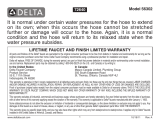Page is loading ...

Installation instructions
4 Connect Tapered End of Hose to Hand Shower
Seat the washer, if provided, firmly into the hose nut. Remove the
yellow tape from the end of the hose that screws onto the hand shower.
Carefully align the thread of the tapered end of the Hose directly to the
Hand Shower. Hand tighten - do not use a wrench or pliers. Then place
the Hand Shower into the wall mount.
3. Install Shower Arm and Hand Shower
It is recommended to wrap plumber tape (not included) around the
threads of the shower arm only.
3A. Standard Installation: A washer, if provided (some of our hoses are
washerless), must be firmly seated into the bottom of the standard hex nut
end of the Hose. Then firmly hand tighten the hose nut clockwise onto
the water supply. DO NOT use a wrench or pliers. If your Hose has Hose
nuts, as pictured in 3A; a vacuum breaker may be required for installation.
If your hose is not equipped with a vacuum breaker, in order to make your
product backflow compliant a vacuum breaker will need to be added.
Installation with a Vacuum Breaker: If a Vacuum Breaker is required for your installation, the
Vacuum Breaker should be connected to the standard hex nut of the Hose and then attach it to
the Shower Arm at the water supply connection. If you attach the Vacuum Breaker to the Hand
Shower, it will not function as desired.
3B. Vacuum Breaker Hose Installation: Your shower hose is equipped with a Vacuum Breaker,
permanently installed in the end of your hose that has a ridged nut (as pictured in 3B). Hand tighten
the ridged nut clockwise to the water supply. Do not use a wrench or pliers. If you attach the ridged
nut to the hand shower, the Vacuum Breaker will not function.
Note: A Vacuum Breaker is a device that is required by certain code authorities to protect your water
supply from the back-flow of impure water. The Vacuum Breaker usually discharges a small amount
of water each time you turn on your shower. It may also drain water when you shut it off. Both are
normal conditions – the water is draining not leaking.
DO NOT TRY TO REMOVE OR TIGHTEN THE VACUUM BREAKER which is permanently installed
into the hose. This could cause damage to the mechanism.
1. Remove Existing Shower Head
Turn the existing shower head counter-clockwise with adjustable wrench
or pliers. Use care not to unscrew the shower arm; hold the shower arm
secure. Note: If your shower arm has a ball on the end of it, it will
not work with this shower unit and will need to be replaced with a
standard shower arm.
2. Install Wall Mount
Select wall position desired for your hose length. Prior to mounting, hold
up the gray mounting base with the circular handle in an ”up” position.
Determine type of mount for your application. For mounting into Tile:
Drill 1/4” holes in grout (if possible) and use enclosed anchors and screw
mount to base. For mounting into Fiberglass/Acrylic: Drill 1/4” holes
(larger if needed for specific toggle bolts) in wall and install with small
toggle bolts (not supplied).
For Adhesive Mounting: Clean the surface area with extra-fine steel
wool; then apply rubbing alcohol or fingernail polish remover to prepare
the surface and wipe clean. Caution: The first position must be
correct, as you cannot move the mount after adhering to the surface. Peel off the green backing
film and position holder upright. Press firmly into place. ALLOW 24 HOURS BEFORE USING. Snap
shell cover over the base on the wall.
Ridged
Nut
= 3A
= 3B
DMI-72639 Rev. A.indd 3 11/16/11 2:15 PM
Page is loading ...
Page is loading ...
/
